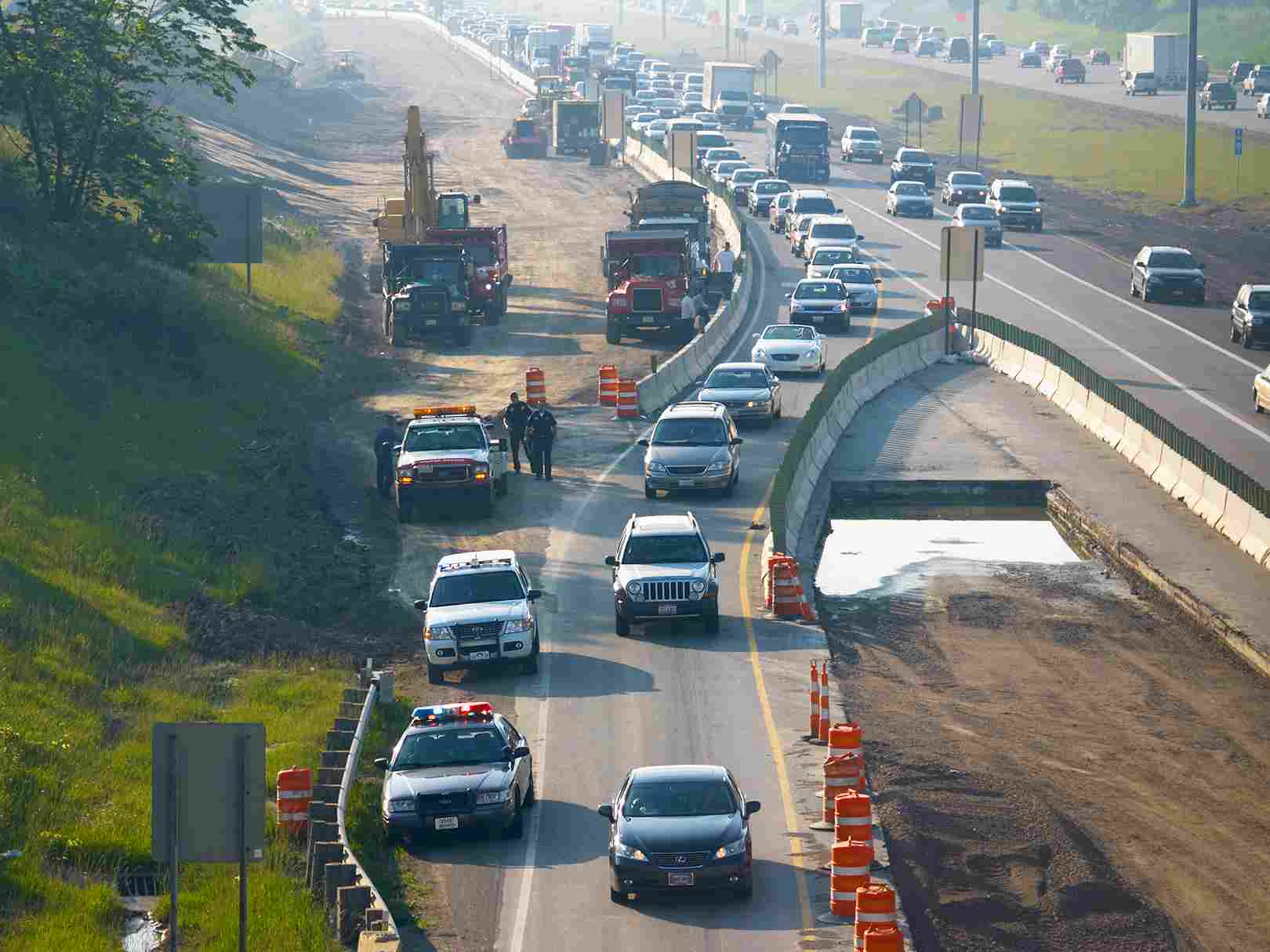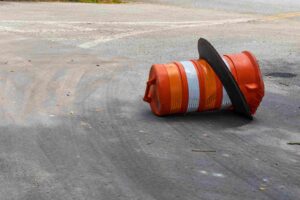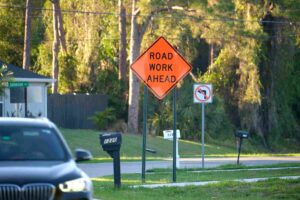
- Vaughn A. Wamsley
- Accidents
When lanes narrow, cones go up, and crews enter the roadway, everything about a typical car crash analysis changes. Work zones create shifting speed limits, new traffic control devices, and duties that drivers and contractors must follow with care.
As Indianapolis car accident lawyers, we have helped thousands of Hoosiers navigate these cases, and we know how to prove fault when a collision happens inside a construction zone.
Our law firm has decades of experience and a record of results for accident victims across Indiana, and we bring that experience to every work zone case we handle.
Why Construction Zones Change the Fault Analysis
Temporary Speed Limits and Special Enforcement
In an active worksite, the posted speed limit may drop and change block by block. Under Indiana Code, agencies can establish temporary maximum speed limits in and around a worksite and must post signs that notify drivers. If drivers exceed those temporary limits, they can be cited, and a citation or camera record often becomes persuasive evidence of negligence in a civil case.
Indiana also launched Safe Zones, a program that uses automated systems to monitor speeds in highway work zones. Violations are triggered under specific conditions: when a vehicle travels 11 mph or more over the posted limit, workers must be present, and multiple warning signs must be posted.
In 2025, state officials announced fines would begin via these cameras after the pilot period. These enforcement tools are not just about tickets. They produce data that can help show who was driving too fast for conditions when a crash occurred.
Extra Duties to Obey Flaggers and Devices
Indiana law requires drivers to obey official traffic control devices and to exercise extraordinary care when a flagger is controlling traffic at a worksite. Disregarding a flagger or a temporary signal can be powerful evidence of fault.
Move Over and Slow Down Obligations
When drivers approach a stationary road, street, or highway maintenance vehicle or construction vehicle displaying amber lights, they must either change lanes away from it or slow to at least 10 mph below the posted limit if a lane change is not safe.
Failing to move over or slow down can shift fault sharply onto the driver who ignored the law.
Common Indianapolis Work Zone Crash Scenarios We See
- Lane-shift sideswipes. Narrowed lanes and tapered transitions increase the risk of sideswipes when drivers do not maintain lane discipline or check blind spots.
- Rear-end crashes in slow queues. Stop-and-go traffic forms quickly around lane closures. Following too closely in a queue is a frequent cause of rear-end impact.
- Merging at temporary bottlenecks. Short tapers or aggressive merging behavior at the head of the closure can cause sudden braking and multi-vehicle collisions.
- Equipment and haul-truck entries. Construction equipment entering the live lane without adequate flagging or sight distance can create unexpected hazards.
- Night-work visibility issues. Poor lighting, missing channelizing devices, or unlit work vehicles can support claims that the traffic control plan was not implemented safely.
Each scenario raises different questions about driver negligence, the setup of temporary traffic control, and whether the contractor and agency followed the Indiana Manual on Uniform Traffic Control Devices (IMUTCD) and the temporary traffic control plan approved for that project.
Who Can Be at Fault in an Indianapolis Construction Zone Crash?
Other Drivers
The most common culprits are drivers who speed through a work zone, ignore a flagger, text in slow-and-go traffic, or fail to move over. A speeding ticket, Safe Zones violation notice, or body-cam footage from an officer who observed the violation can be crucial evidence that the driver breached a statutory duty.
Contractors and Subcontractors
Contractors must implement and maintain the temporary traffic control plan and keep the site reasonably safe. When signs are missing, tapers are too short, channelizing devices are not replaced after a hit, or ingress and egress points are unsafe, liability can shift to the road contractor or traffic control subcontractor. Compliance is measured against the IMUTCD and INDOT specifications.
Government Entities
INDOT or a city may share fault if a work zone is designed or operated unsafely. Claims against government entities are governed by the Indiana Tort Claims Act (ITCA), which imposes strict notice deadlines and limits on damages.
While there are immunities for certain discretionary decisions and older highway designs, agencies still have a continuing duty to maintain highways in a reasonably safe condition. Strategic investigation can reveal whether immunity truly applies or whether negligent maintenance or operations fall outside those protections.
How Comparative Fault Works in Indiana Work Zone Cases
Indiana uses modified comparative fault with a 51 percent bar. If a jury finds you 50 percent or less at fault, your recovery is reduced by your percentage of fault. If you are greater than 50 percent at fault, you recover nothing. This is why evidence of speeding, ignoring a flagger, or violating a temporary sign can be outcome-determinative.
Example: A jury values losses at $200,000 after a car accident in Indianapolis, Indiana. The at-fault driver was speeding through a lane closure. You were following a bit too closely. If the jury assigns 20 percent fault to you and 80 percent to the speeding driver, you would recover $160,000. If it flips to 60 percent against you, recovery would be barred.
Special Evidence That Wins Construction Zone Cases
The right evidence makes or breaks a work zone claim. Our team moves quickly to preserve and analyze:
- Police report, body-cam, and 911 audio. These can capture candid statements and lane configurations at the time of the crash.
- Dash-cam and EDR data. Vehicle data recorders can reveal speed and braking before impact.
- INDOT Safe Zones data. If a camera was active, violation records can corroborate speeding by the other driver.
- The traffic control plan and daily logs. We obtain the approved MOT plan, contractor diaries, lane-closure permits, and inspection notes to verify whether signs and tapers matched the plan and IMUTCD.
- Work zone crash statistics and hazard profiles. INDOT publishes work zone safety data that helps explain why a site requires enhanced protection and reduced speeds.
- Witnesses, including crew members. Worker testimony can show whether temporary devices were set correctly and replaced after impacts.
- Photogrammetry and scene mapping. Measurements of taper length, cone spacing, and sight distance often rebut claims that a driver should have seen a hazard.
Deadlines and Special Rules That Can Shorten Your Time to Act
Standard Statute of Limitations
The general rule in Indiana is two years from the date of the collision to file a personal injury lawsuit. Missing this deadline can end your claim, even if liability is clear.
Shorter Deadlines When a Government Is Involved
If INDOT or a city or county agency may share responsibility for a construction zone setup, special notice rules apply under the Indiana Tort Claims Act. You must serve a Notice of Tort Claim within 270 days when the State of Indiana or a state agency is involved, and within 180 days when the claim is against a political subdivision such as the City of Indianapolis or Marion County. Missing these notice deadlines can bar the claim even if liability is substantial.
The statute also requires that claims against a political subdivision be noticed to the governing body and, where applicable, the Indiana Political Subdivision Risk Management Commission. There are narrow exceptions, for example, when a subdivision was not a member of the risk pool at the time. These service requirements are technical and easy to get wrong, which is one reason to contact an Indianapolis car accident lawyer quickly.
Indiana law caps recoveries against government entities at $700,000 per person and $5,000,000 per occurrence, and punitive damages are not permitted against a governmental entity. These caps can shape strategy, settlement posture, and the number of potentially responsible parties we pursue.
What To Do Immediately After a Construction Zone Crash
If you are in an auto accident in Indianapolis during road work, a few focused steps can protect both your health and your claim:
- Call 911 and Get Medical Care. Even if symptoms feel mild, seek evaluation. Delayed headaches or neck pain can be significant.
- Document the Work Zone. Photograph lane closures, taper lengths, missing or displaced cones, sign faces, warning signs, changeable message boards, flagger positions, queue length, and lighting.
- Note Safe Zones Signage. If the work zone had automated speed enforcement signs, capture them. We will obtain speed-camera records if they exist.
- Identify Contractors. Photograph company logos on trucks or traffic control devices. Subcontractor identities matter.
- Preserve Vehicles. Do not authorize early disposal. We often download the event data recorder to capture pre-impact speed and braking.
- Request Body-Cam and 911 Audio. Response recordings are often time sensitive and can capture lane configurations and admissions.
- Call an Attorney Early. A prompt investigation can secure the traffic control plan, daily work logs, and INDOT records before they change. If a government is involved, 180-day or 270-day notice clocks may already be running.
Damages Available After a Work Zone Crash
When a private driver or contractor is responsible, available damages can include:
- Medical Expenses. Emergency care, imaging, surgery, physical therapy, and future care.
- Lost Income and Earning Capacity. Pay stubs, tax returns, and expert analysis help document these losses.
- Pain, Suffering, and Loss of Normal Life. The human impact of an auto accident in Indianapolis has real value under Indiana law.
- Property Damage and Diminished Value. Repairs are only part of the story when a vehicle loses market value after a major crash.
- Out-of-Pocket Costs. Medications, mileage, home modifications, and replacement services.
When a government entity is potentially liable, ITCA damage caps apply, and punitive damages are not available, which can limit recovery and make identification of private parties even more important.
Frequently Asked Questions About Indianapolis Work Zone Crashes
Do Automated Work Zone Cameras Affect My Civil Case?
Yes. Indiana’s Safe Zones program uses automated systems to document vehicles that travel 11 mph or more over the posted work zone limit, with multiple warning signs and workers present. Violation data can corroborate negligence, and we request those records where available.
What If A Flagger Waved Me Through And I Was Hit?
Flagger signals control the lane when posted. If a clash between temporary signs and a flagger’s signal created confusion, liability can involve both the driver who failed to yield and the entity responsible for temporary traffic control. The Indiana MUTCD and the project’s traffic control plan guide that evaluation.
Do I Still Have A Case If I Was Going A Little Over The Limit?
Possibly. Comparative fault does not eliminate a claim unless you are found more than 50 percent at fault. We look at all evidence, including whether the taper length, sign spacing, and lighting met standards, and whether other drivers were also negligent.
What Makes Construction Zone Cases Different For Insurance?
Insurers often argue that sudden slowdowns are unavoidable and that everyone should anticipate taper merges. We counter by proving specific violations, obtaining EDR data, and comparing the field setup to INDOT and Indiana MUTCD requirements. This is where an accident lawyer in Indianapolis, IN can make a real difference.
How Long Do I Have To File Suit?
Most personal injury cases in Indiana have a two-year statute of limitations. If a government may be liable, you must also meet the ITCA notice deadlines of 180 days or 270 days.
How Our Law Firm Builds A Winning Work Zone Case
We bring a structured approach that aligns with Google’s E-E-A-T principles of experience, expertise, authoritativeness, and trustworthiness:
- Early Scene Work. We secure photographs, Safe Zones details, and contact information, and we move to preserve vehicles and EDR data.
- Standards Comparison. Our team obtains the traffic control plan and compares it against the Indiana MUTCD and INDOT manuals to identify deviations that increase risk.
- Witness and Crew Interviews. We document how the crew managed lane closures, lighting, and device replacement.
- Medical Proof. We connect clients with appropriate specialists and document causation and prognosis.
- Damages Modeling. We project future medical and work impacts to support negotiation and trial.
- Negotiation And Litigation. We pursue the responsible driver, the contractor, and, where appropriate, a governmental entity, while navigating ITCA caps and notice requirements.
Our Indianapolis car accident lawyers have decades of experience, a record of significant results, and a local office that serves clients across Central Indiana. We invite you to review our background and results to understand how we advocate for people after a car accident in Indianapolis, Indiana.
Local Insights: Indianapolis Work Zones Right Now
Major INDOT projects rotate throughout Marion and Hamilton Counties, and the I-465 and I-69 Clear Path area has recently seen active camera enforcement. If your crash happened near a current project, let us know the precise location so we can pull the plan sheets, permits, and any Safe Zones records.
When To Call An Attorney
If your car accident happened inside or near a lane closure, do not assume fault is obvious. Construction zones layer temporary rules on top of everyday driving duties, and small details decide who pays. Contact an auto accident attorney in Indiana as early as possible so we can preserve evidence, meet the 180-day or 270-day notice deadlines when needed, and protect your right to full compensation.
We are here to help Indianapolis drivers after any auto accident, including complex work zone crashes. Reach out to our team of Indianapolis car accident lawyers for a free consultation. As a dedicated accident lawyer in Indianapolis, IN, we are ready to listen, investigate, and take action.



